There is probably nowhere in the world you will find more information on the juxtaposition of tennis and wristwatches than right here at Quill & Pad. Unless, that is, you are an ardent follower of Miguel Seabra on his social media channels.
After noticing another flux of new tennis sponsoring by watch brands happening over the last few months, I asked Seabra – a noted tennis/timepiece expert and Eurosport commentator in Portugal – for a few of his observations.
“I don’t know whether these days the association between watch brands and tennis is stronger than before, but for sure it seems more visible due to the advent of social media,” Seabra explains. “But tennis and timepieces have a long history together because tennis always had a prestigious aura quite appealing to the luxury market and is indeed one of the most telegenic sports out there.”
He’s right, too. In 2018 two of each of these disciplines’ biggest names celebrated 40 years together: Rolex and Wimbledon. In Rolex and Wimbledon: A Match Made In Traditional (Tennis) Heaven, I opened with “. . . there are few brands that fit so well together, emulating each other in a way – though a fully unplanned way – with their staunch holds on traditionalism and domination of their respective fields.”
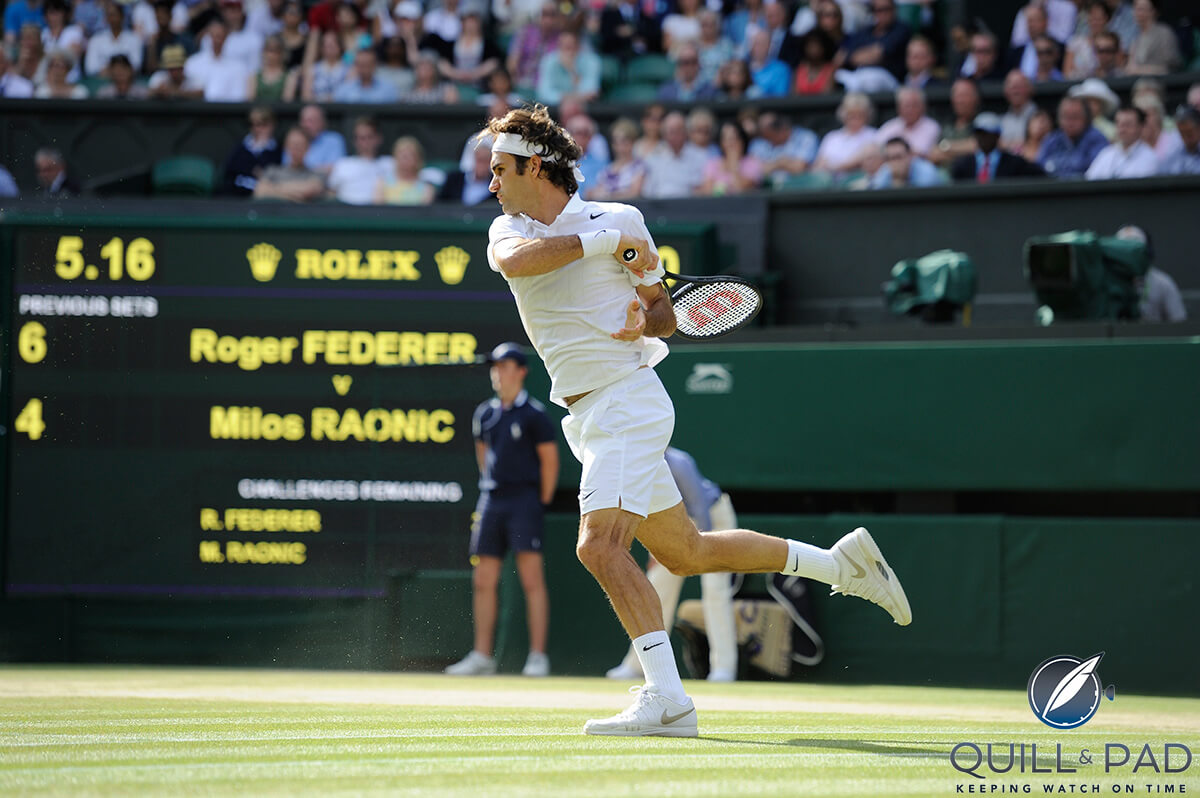
Rolex ambassador Roger Federer at Wimbledon
It was also 40 years ago in 1978 when the term “sport marketing” was first coined. And as I go on to argue in that article, 1978 turned out to be the pivotal year for any and all brands to decide to spend their marketing money on sport sponsoring. So it should not be surprising that Rolex bounced into tennis by partnering with the biggest and best known tennis event in the world, Wimbledon.
Rolex’s domination in tennis now includes the U.S. Open
“Of course, Rolex became the biggest reference in the world of sports sponsoring, and particularly in tennis, this year celebrating the 40th anniversary of its deal with Wimbledon arranged via IMG (International Management Group), who took over the business side of the Championships and followed up in tennis with the strategy they already used in golf,” Seabra points out.
As of 2018, Rolex is the official timekeeper of the majority of important tennis tournaments in the world, “from the lower ATP World Tour 250 echelon in Estoril and Geneva right up to the Masters 1000 events, the ATP and WTA year-end championships, Davis Cup, Fed Cup, and three out of four Grand Slams,” Seabra recounts.
Rolex has also just announced a brand-new multiyear partnership with the United States Tennis Association, which includes sponsorship of the Cincinnati Masters Tournament (completing a monopoly-like sponsorship of all nine of the Masters 1000 events), the USTA National Campus in Orlando, supporting the USTA Foundation (the organization’s charitable arm), and becoming the official timekeeper and the official timepiece of the U.S. Open.
“Having such a relevant director who was a good tennis player like Arnaud Boetsch (former number 13 in the world rankings and a Davis Cup hero, clinching the 1996 trophy for France in epic fashion) certainly helped Rolex become one of the biggest sponsors in the game, if not the biggest due to its widespread influence in the calendar and across all continents,” Seabra comments.
“And there’s never been another ambassador like Roger Federer, who is not only Swiss but embodies a lot of what this ‘crowned’ brand stands for. In the late 1970s or early 1980s I don’t recall the biggest stars – other than Aussie great John Newcombe for Rolex, if memory serves – being high-profile ambassadors for watch brands. Bjorn Borg had more sponsor deals than a Formula 1 team, but was not clearly associated to a watch brand, even though in recent years Rolex has added him to its ever-growing stable of greats.”
Whirlwind personified: Richard Mille, Rafael Nadal, and the Gerry Weber Open
I bring Seabra back to my original question regarding the seeming flux of new tennis/timepiece sponsor pairs, which he promptly answers.
“The biggest difference right now is there are more players, and especially high-profile champions, with well-publicized watch deals. Having said that, let’s put things into perspective: many seem surprised when someone plays tennis with a watch on, and Rafael Nadal attracted a lot of attention [this way] when he started with Richard Mille back in 2010, followed by Stan Wawrinka and Serena Williams also amassing Grand Slam titles wearing bulky Audemars Piguet timepieces on their wrists.
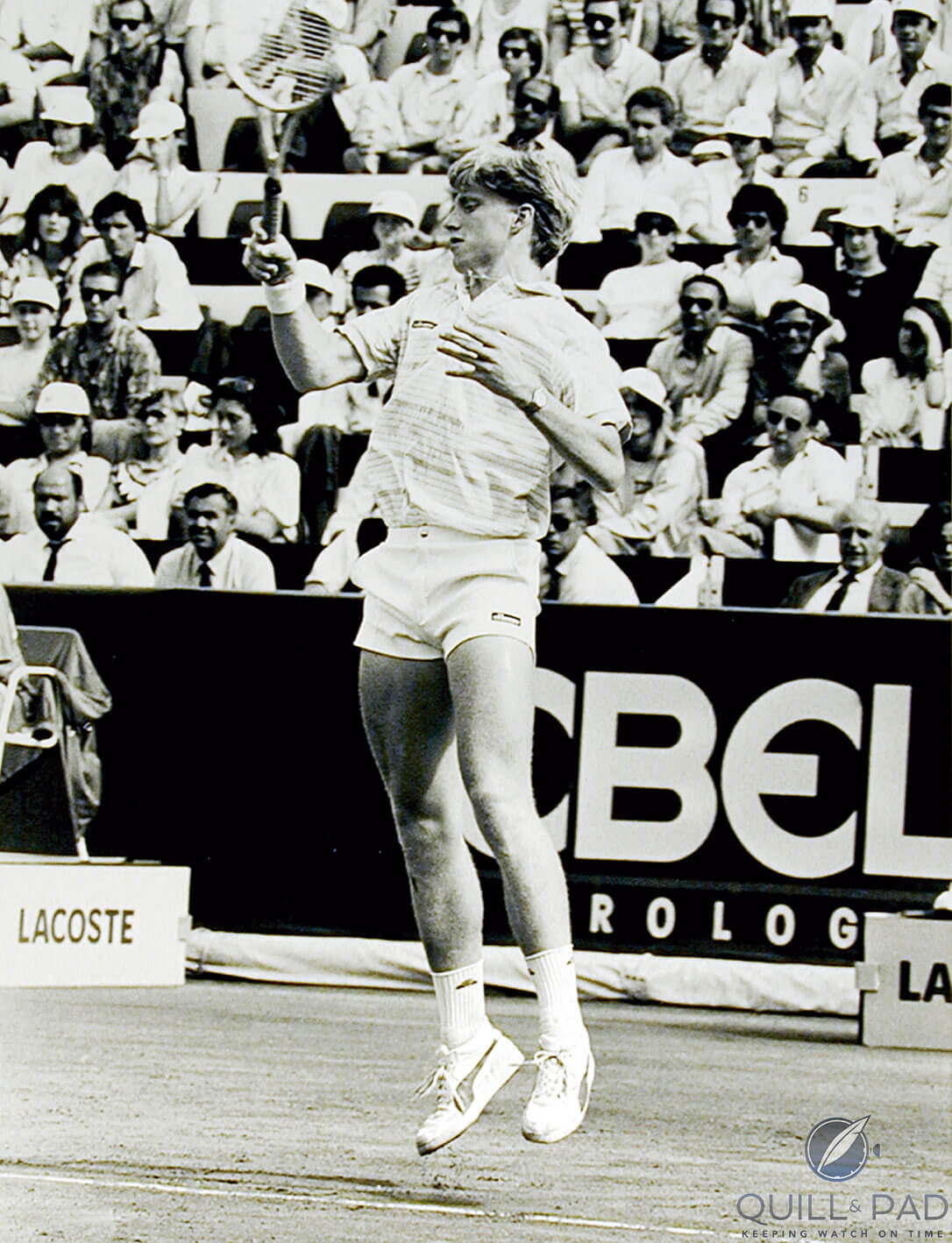
Boris Becker wearing an Ebel watch on court in the 1980s (photo courtesy Ebel)
“I’ve even heard [former tennis professional, now Eurosport commentator] Mats Wilander saying in commentary that he didn’t know how the Spaniard could wear a timepiece on court. But, funny enough, I remember quite well Wilander himself playing Grand Slam finals with a watch on back in 1987, some cheap plastic brand, I never really knew which one it was. And this was not an isolated case: I also remember Boris Becker winning Wimbledon wearing an Ebel and Andre Agassi [now a Longines ambassador] in his denim shorts days circa 1988 playing with an Ebel that featured a blue-jean strap with red hearts!
“Back then, in the 1980s and through to the mid-1990s, Ebel was huge, right up there with Rolex in terms of visibility, sponsoring players and events such as the Davis Cup. There were a lot of smaller tennis events associated with more or less relevant watch brands, and the deals made were mainly due to local retailers (off the top of my head I can recall Korloff in Lyon) instead of a global marketing strategy like the one Rolex has right now.”
One of the hottest new brands to get involved with tennis sponsoring is Richard Mille, who began with Nadal almost a decade ago and has now also signed the volatile, talented young Alexander Zverev (currently world number 3) as well as tournaments like the Gerry Weber Open, where Richard Mille made its debut as official timekeeper in June 2018.
The Gerry Weber Open, one of only seven grass court tournaments on the ATP calendar, is an ATP World Tour 500 – meaning it comes right after the ATP World Tour Masters 1000 in importance. It is also Germany’s largest tennis event as well as being the third largest in Europe. The third most watched tennis event in Germany (television, streaming, etc.), it enjoyed about 4,000 hours of television coverage in a variety of countries, boasting more than 33 million individual viewers. Aside from that, the 2018 edition attracted more than 450 media professionals on site, so coverage is dynamic and international.
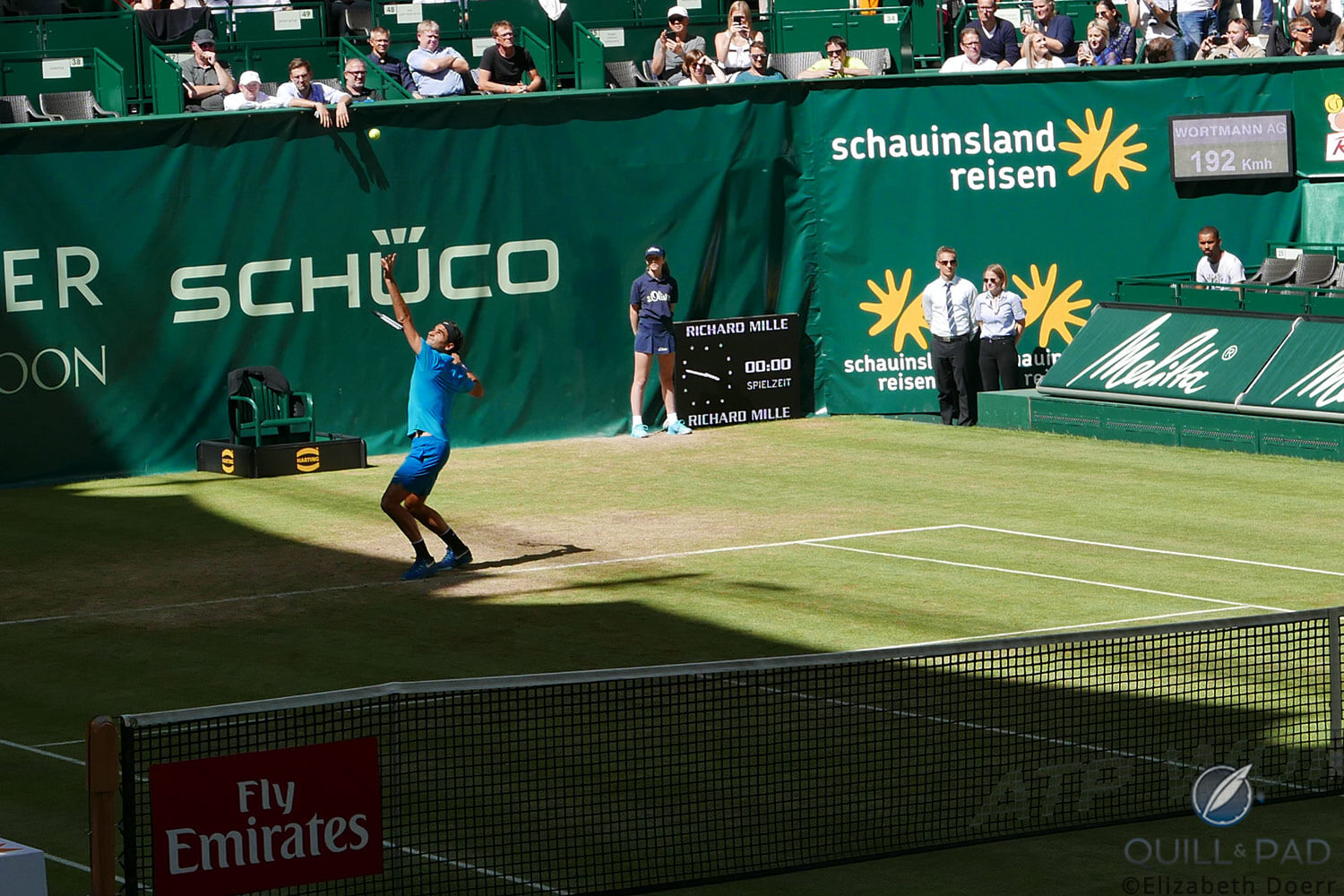
Roger Federer at the 2018 Gerry Weber Open in Halle, Germany: note the new Richard Mille clock on center court
And, as tournament director Ralf Weber noted of the 2018 edition, “Spectator interest has been at an impressively high level with a total of 115,000 individuals attending the tournament over its nine days.”
Having had the chance to visit the tournament for two days with Richard Mille in 2018, I’m not surprised to learn this: the party atmosphere of the site and its “side shows” that include spectacular gastronomy combined with the all-star draw including Federer, Zverev, and more will certainly attract those who are even only mildly interested in the sport.
“Richard Mille is a good brand to be involved in any individual sport because its watches are tested on the field,” Seabra reminds me. “The policy of the brand was to always take the watches out there and make them prove they work under extreme conditions. And there’s no other player that could personify the whirlwind concept of a tourbillon better than the effervescent Rafa Nadal.”
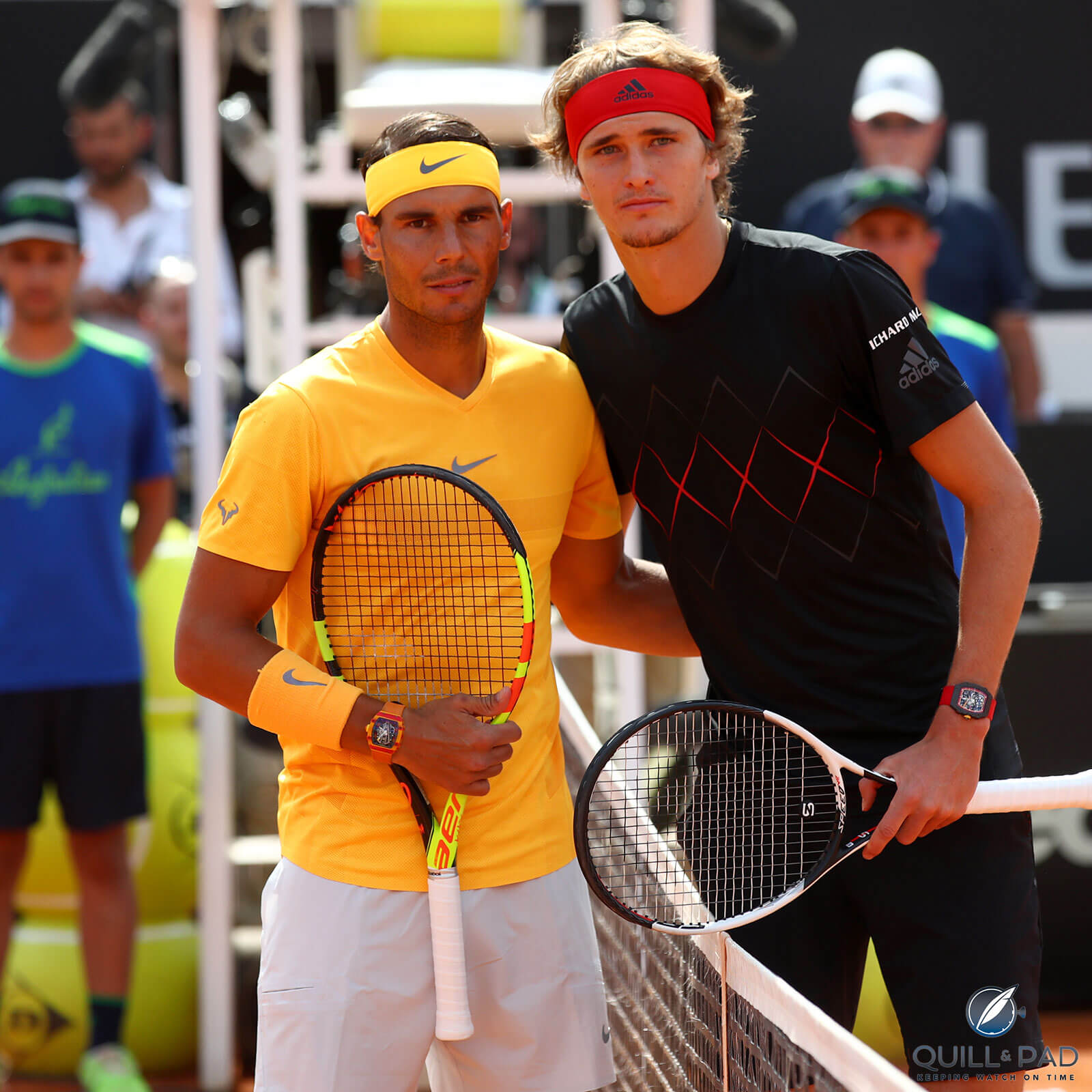
Rafael Nadal wearing his Richard Mille RM 27-03 and Alexander Zverev wearing his RM 67-02 before the men’s singles finals of the Internazionali BNL d’Italia 2018 in Rome (photo Julian Finney/Getty Images/Richard Mille)
Surprise entries in the tennis world
“For the past two years, H. Moser & Cie. has been the official timekeeper at the Mercedes Cup in Stuttgart, held not too far from the brand’s headquarters in Neuhausen on the Swiss side of the border. It’s one of those cases where the sponsorship deal was made through the brand’s local agent,” Seabra says.
I joined Moser for a day at the 2018 edition of the Masters 250 event, which was a relaxing way to take a look at some cool Moser watches while enjoying the top-notch tennis served up by players like Federer.
Moser has no further ties to the world of tennis, and I now understand why the boutique brand took on the partnership in combination with a local agent: access to the type of clientele that attends such an event. In Europe, people interested in tennis generally have some money as the sport is not inexpensive to play, nor is it cheap to watch live. These are certainly the type of people a brand like Moser wants to be in direct contact with. And that goes for all the luxury watch brands.
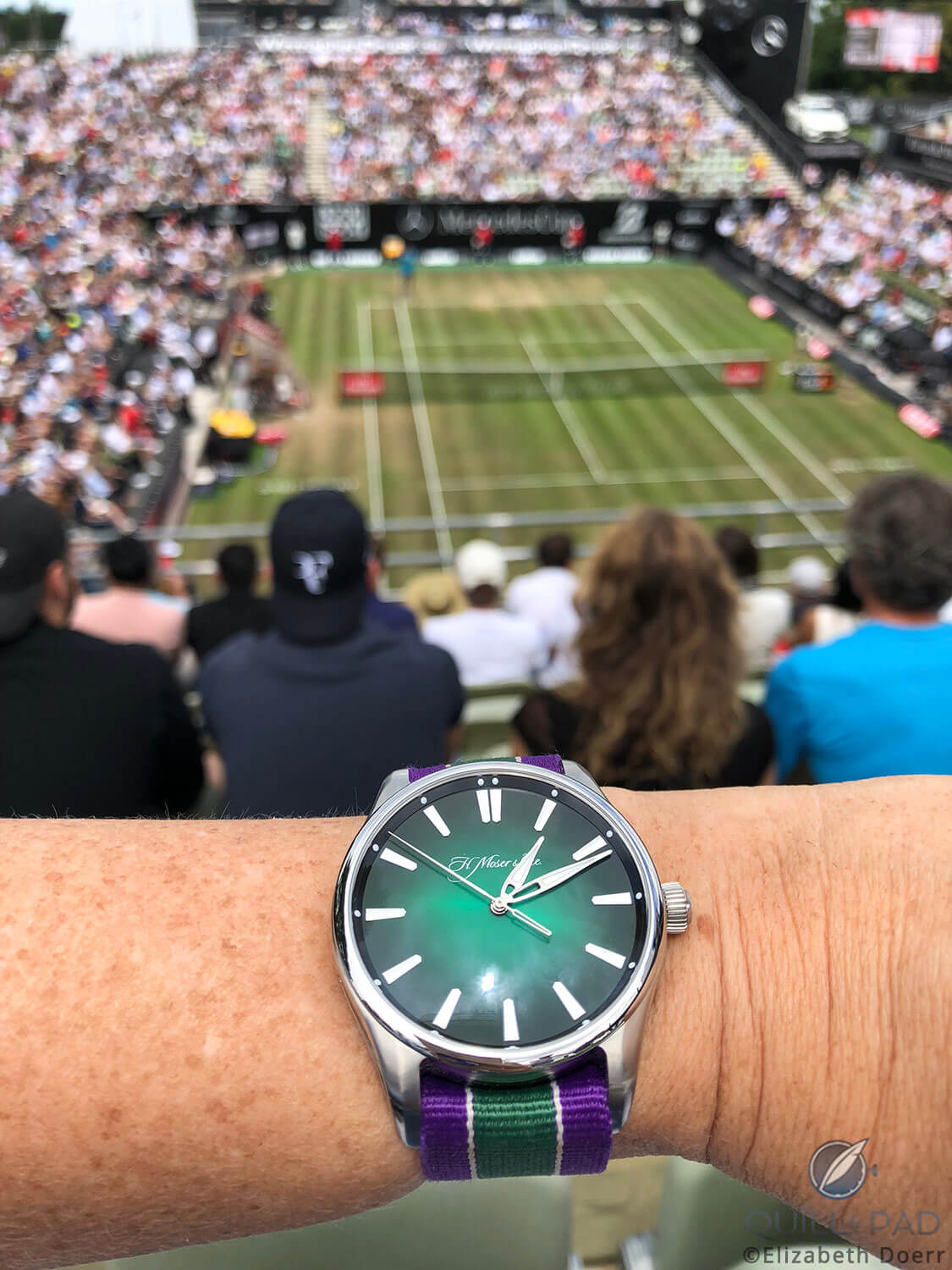
The H. Moser Cie Pioneer Center Seconds Cosmic Green on a Wimbledon-inspired NATO strap by Maurice de Mauriac designed by Miguel Seabra at the Mercedes Open 2018
“Another aspect to be considered is the fact that some contemporary tennis stars became true watch aficionados, reading everything they can about the subject,” Seabra continues. “Believe it or not, the first time I’ve ever heard about Hodinkee was through former Swedish star and two-time Roland Garros runner-up Robin Söderling in 2008. Robin was quite an educated fan, just like Tomas Berdych (who had a surprising watch deal with African luxury goods designer Felio Silby for a while) and [Rolex ambassador] Grigor Dimitrov. Of course, let us not forget Gael Monfils, once a De Bethune ambassador and a Grand Prix d’Horlogerie de Genève juror for two years running, who had the good taste to show up at last year’s ceremony wearing a Kari Voutilainen!
“And Aussie player Matt Ebden, who has a Grand Slam title under his belt (mixed doubles at the Australian Open) and an association with Zurich-based boutique brand Maurice de Mauriac, certainly is the most studious right now among the top 100, frequently reaching out and asking me pertinent questions about a particular watch, brands, or the industry in general.”
The most original tennis/timepiece project according to Miguel Seabra
“Finally, the most original tennis-and-timepiece project that I know of is one that was dissected last year here on Quill & Pad in Avantist Launches A Watch Containing A Piece Of String From Martina Navratilova’s Wimbledon-Winning 1987 Raquet. The Legend Series from new independent watch brand Avantist features a length of racquet string encapsulated around the center of the dial. But not any string segment: we’re talking about Grand Slam-winning material!
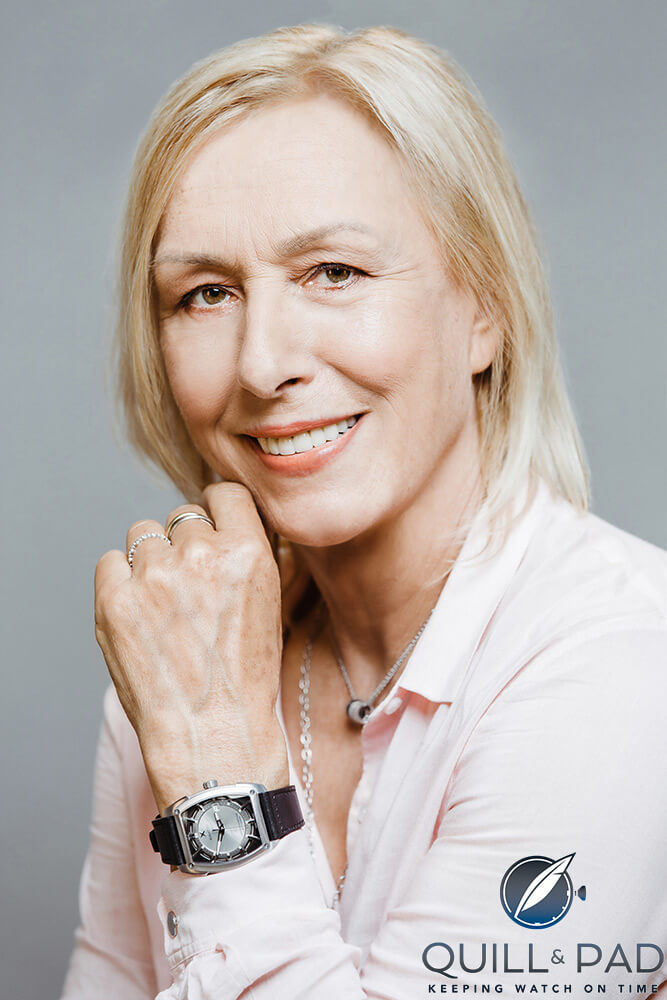
Martina Navratilova wearing the Avantitst Legend Series Navratilova watch
“Avantist founder Keeran Janin, through his friend and doubles great Leander Paes, established a partnership with the legendary Martina Navratilova for a limited series of watches featuring the strings that the Czech-born American champion used on five (for now) of her 18 Grand Slam-winning finals. There have been many tennis-related watches, but never one quite like Avantist timepieces. I’ve tested one for a month and it actually gives you the sense of wearing a piece of tennis history on the wrist. It’s the perfect tennis memorabilia watch; besides, it is also a great conversation starter!”
Follow Miguel Seabra on Facebook, Instagram, and Twitter for colorful commentary on tennis and timepieces!
You may also enjoy:
Rolex and Wimbledon: A Match Made In Traditional (Tennis) Heaven
Ace: A Rolex Explorer, Wimbledon, And The Maurice De Mauriac Lawn Tennis NATO Strap
Time For A Contender: Meet Tomas Berdych, The Tennis Champion With A Passion For Watches
Alexander Zverev’s Ultra-Light Richard Mille RM 67-02 Is Serving Aces
Avantist Launches A Watch Containing A Piece Of String From Martina Navratilova’s Wimbledon-Winning 1987 Raquet
Richard Mille RM 27-02 For Rafael Nadal: The Quintessential Sports Tourbillon
Rafael Nadal, The World‘s No.1 Tennis Player; The Richard Mille RM 27-01, The World’s Most Expensive Sports Watch; And The Ion Tiriac Trophy, The World’s Most Complicated Tennis Trophy





















































Leave a Reply
Want to join the discussion?Feel free to contribute!